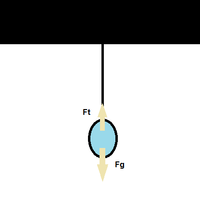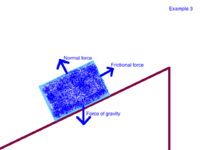Free Body Diagram: Difference between revisions
| Line 49: | Line 49: | ||
== Connectedness == | == Connectedness == | ||
While free body diagrams do not necessarily correlate with my life, they do have an application in the real world. For companies designing things such as billboards and even things such as houses, free body diagrams can be used to solve for how much force the structure must be supporting before construction begins. | While free body diagrams do not necessarily correlate with my life, they do have an application in the real world. For example, companies designing things such as billboards and even things such as houses, free body diagrams can be used to solve for how much force the structure must be supporting before construction begins. | ||
== See also == | == See also == | ||
Revision as of 00:02, 5 December 2015
A free body diagram, or force diagram, is a drawing of an object that is used to show all of the forces acting on the body. In mechanics, free body diagrams are extremely helpful because they allow visualization of each force acting upon the object. There are various forces that can be acting on the object, such as applied force, frictional force, normal force, and gravitational force. However, free body diagrams are not limited to these. All forces on a free body diagram are due to the body's interactions with its surroundings.


How To Draw a Free Body Diagram
Free body diagrams are usually used in collaboration with Newton's Second Law, F=mass*acceleration, as both are typically used in the process of solving for force. To create a free body diagram, it is most beneficial if the system and surroundings are identified, and any forces that are identified to be negligible do not need to be drawn on the diagram. A box or point is usually used to model the system in a free body diagram. Each force is typically represented by an arrow, which is drawn in the direction in which they act on the system. The size of each arrow, though not completely to scale, should mirror the magnitude of the force. Each of these arrows should be labeled as a certain force to avoid confusion when solving problems.
Types of Forces to Consider for Free Body Diagrams
Although all of these forces are not always present in every situation, some of these forces will usually be present acting on a system.
- Applied Force: This is the force applied to the system by a person or other object.
- Force of friction: This is the force that a surface applies on the system that is moving (or trying to move) on that surface.
- Important formula: f=μN f=frictional force N=normal force
- Force of gravity: The force of gravity is the force that, on Earth, will act downward toward the center of the Earth.
- Important formula: Force of gravity=mg where m=mass g=9.8 m/s^2
- Normal force: This is a force that is present when the system is on another object or surface, and the object or surface is exerting a force on the system as support.
- Spring force: The spring force is a force that is exerted by a spring onto any system that is attached to it.
- Important formula: Spring force=-kx where k=spring constant x=the displacement from the spring's relaxed position
- Force of tension: This is the force that exists when a rope, string, wire, etc. is pulling on the system.
These are just the most common forces for free body diagrams in mechanics; however, other forces also exist.
Examples
Simple Example 1: A person rides in an elevator moving at constant velocity. Create a free body diagram to represent this situation.

Middling Example 2: A ball is hanging on a string of negligible mass from the ceiling. Create a free body diagram to model this situation.

- Note: For this example, when solving for forces, the force of tension must be split into horizontal and vertical components and solved.
Difficult Example 3: A stationary box lies on an incline. Create a free body diagram to model this situation.

- Note: Friction is necessary to keep the box stationary. When solving for the normal force and for frictional force, both the x and y component must be considered.
Diagrams with solution are on the left and right.
Connectedness
While free body diagrams do not necessarily correlate with my life, they do have an application in the real world. For example, companies designing things such as billboards and even things such as houses, free body diagrams can be used to solve for how much force the structure must be supporting before construction begins.
See also
http://hyperphysics.phy-astr.gsu.edu/hbase/force.html
http://www.physicsclassroom.com/class/newtlaws/Lesson-3/Newton-s-Second-Law
References
http://hyperphysics.phy-astr.gsu.edu/hbase/freeb.html
Matter and Interactions: Modern Mechanics. Volume One. 4th Edition.
https://www.wisc-online.com/learn/natural-science/physics/tp1502/construction-of-free-body-diagrams